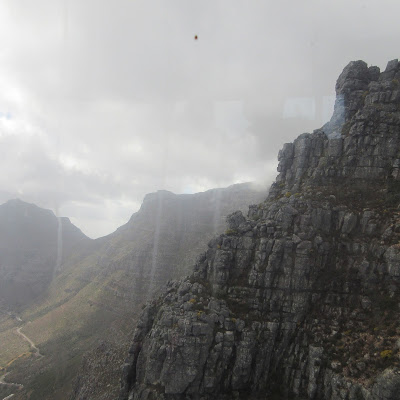We had noticed how poor service was for breakfast in Le Vendome. Their system, if they had one, was certainly not working and it was really difficult to get your order for tea/coffee or for a cooked breakfast (as in the egg) taken. However, we simply put it down to us having had great service in all the other establishments in which we had stayed (except for the other Radisson Blu in Port Elizabeth). It was no better this morning and Polina was particularly apathetic and even surly!
Our tour today was to start with Table Mountain but Tracey noticed that a mist had descended over the mountain and decided we would not get value from going there immediately. So we started instead with The Cape Malay Quarters. This picturesque quarter is found on Signal Hill and is called Bo-Kaap. It is one of the oldest parts of Cape Town and one of the few to have retained its historical character. It owes much of its character to its mostly single-storey houses with flat roofs painted in a variety of pastel colours and to its cobble-stoned streets. Tracey tells us that it is multi-religious, multi-racial and multi-coloured! There are 17 mosques there as it has traditionally been a muslim area.
There are a lot of homeless in Cape Town.
Still too soon to go to Table Mountain!
In an alley there are paintings from the past showing how multi-racial the quarter was.
When we got back to the coach Ashley had bought some koeksisters for us. A koeksister is a very sticky South African bun (originated in Bo-Kaap) a bit like a doughnut. It is flavoured with cinnamon and is seriously yummy but sinful!
We passed through Tambourkloof, a very sought after suburb. Apartments there are around 1 million.
Heading up towards Table Mountain.
In 1929 the first cable car was operated. Now the cable car has a revolving floor (rotair) so passengers get a 360 degrees view of the climb - except for me as I stood on a little platform as I was afraid the motion would cause me to fall.
Back at ground level before most of the others, we settled ourselves in a sort of viewing platform from where we could see Tracey.
Then it was time to continue our tour of Cape Town.
This is the Foreshore Freeway Bridge, also known as Cape Town's unfinished bridge. It is an incomplete section of what was intended to be the Eastern Boulevard Highway. Tracey told us that the design team made a construction error which resulted in the two sides of the bridge not meeting up. It has become a tourist attraction and is a popular film and fashion shoot location.
Our next stop was the Castle of Good Hope where we were to explore the fort. This was not to be however, as they were filming "Crowns".
The Castle of Good Hope is in the shape of a 5 pointed star. It is the oldest surviving building in South Africa and has been the centre of civilian, political and military life in the Cape since 1666. Not once has a shot been fired in aggression from it. The bell tower was used to toll the hours and to warn the people of danger.
Cape Town City Hall is built in Renaissance style. It was from the balcony here in 1990 that Nelson Mandela made his first speech as a free man. It is the seat of Parliament but, according to Tracey, it is more like a boxing ring.
We were now making our way through Cape Town on foot to St. George's Cathedral. Desmond Tutu, the first black archbishop of South Africa led numerous marches and campaigns from the steps of St. George's Cathedral.
The Mutual Building is a fine example of art deco architecture and design. It has one of the longest carved granite friezes in the world stretching around the three sides of the building.
On the Darling Street side it depicts Van Riebeek's settlers arriving at the Cape and meeting the Hottentots and the 1820 settlers setting out to establish their homes in the interior.
On the Parliament Street facade are carved heads representing nine ethnic African groups .
Zulu (left) and Bushman.
Barotse (left) and Kikuyu.
Adderley Street Flower Market.
St. George's Cathedral, Wale Street, Cape Town.
The Houses of Parliament.
South African Museum
We were now in the Company's Garden, a park and heritage site in central Cape Town. This is a statue of Cecil John Rhodes.
Following our visit to the museum we continued driving through Cape Town . Bree Street has lots of restaurants and bars, art galleries and shops.
It is hard to believe after a full morning in Cape Town that it was only lunch time. We had lunch by the pool in Le Vendome. It took ages! The waitress kept coming to us to apologise. Following lunch we ewent for a walk along Sea Point as far as the Italian restaurant La Perla which was very busy with Sunday lunchers. We stopped for a glass of wine as we sussed out the restaurant for the evening. However, we were not overly impressed.
It was quite windy so the sea was rough.
That evening we took ourselves back to the V&A for dinner and chose a different restaurant.
This had been our last day of touring with Tracey and Ashley so we had taken our leave of them after the tour of Cape Town. They deserved the generous tips that we gave them.











































































































No comments:
Post a Comment